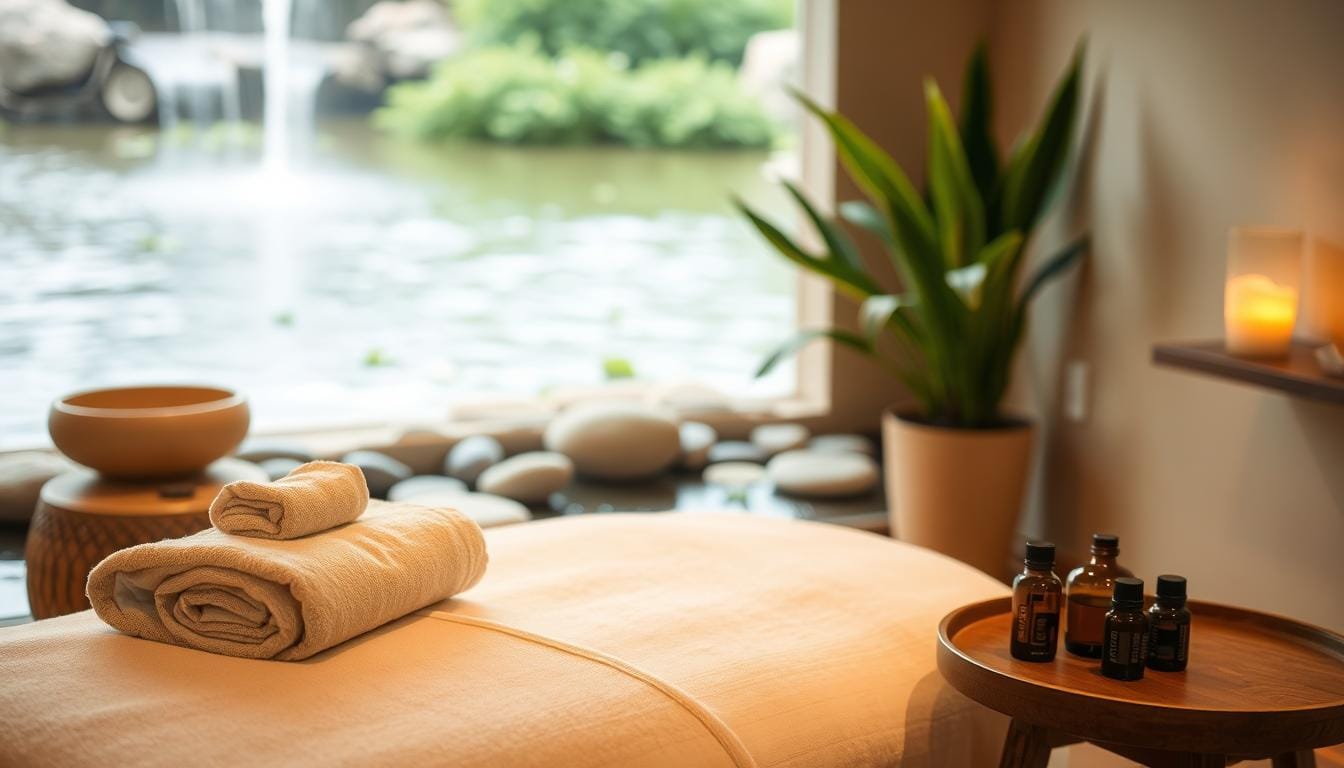טיפול בעיסוי הוא שיטת טיפול ברוחניות הוליסטית עם שורשים עתיקים. זה מקדם רגיעה, מפחית כאב ומשפר את הרווחה הכללית. הטכניקה משתמשת בטיפול ידני ברקמות רכות כדי להקל על מתח ולשפר את הזרימה.
טיפול בעיסוי הוצא לאור בסין העתיקה, במצרים וביוון. מאז הוא התפתח למגוון רחב של טכניקות. כל טכניקה פועלת על צרכים והעדפות ספציפיות.
תחום טיפול בעיסוי מציע הרבה אפשרויות ל-הקלה מתח. אלו כוללים עיסוי שוודי, עיסוי רקמות עמוקות ועיסוי ספורט. עיסוי נקודת הטריגר הוא טכניקה פופולרית נוספת.
הבנת הטכניקות הללו עוזרת לאנשים לבחור באופן מושכל בריאותי. טיפול בעיסוי יכול להיות חלק חשוב מ-תוכנית הרווחה ההוליסטית.
מסקנות מרכזיות
- טיפול בעיסוי הוא שיטת טיפול ברוחניות הוליסטית שמקדם רגיעה ומקל על כאב
- עיסוי טיפולי משתמש בטיפול ידני ברקמות רכות כדי לפתוח על אזורים ספציפיים
- טיפול בעיסוי משתרע בשורשים עתיקים בציבורים כמו סין, מצרים ויוון
- שיטות עיסוי שונות, כגון סוודי, רקע עמוק, ספורט ונקודת טריגר, טופלות בצרכים ספציפיים
- הבנת היתרונות והשיטות של טיפול בעיסוי מאפשרת החלטות מושכלות בקרב תוכניות בריאות הוליסטית
הקדמה לטיפול בעיסוי
טיפול בעיסוי מניה את רכות הרקמות כדי לקדם בריאות ורווחה. המוסר העתיק הזה מקל על כאב ומשפר רווחה. הוא מציע הרבה יתרונות טיפוליים דרך שיטות שונות.
מהו טיפול בעיסוי?
טיפול בעיסוי הוא טיפול ממושך המכוון לשרירים, גידים ורקמות חיבור. מטפלים מאומנים משתמשים בלישה, דיכן ולחץ כדי להקל על מתח ולחץ. המטרה היא לשפר זרימת דם ולשפר רגיעה.
טיפול בעיסוי משלים טיפולים רפואיים מסורתיים. זה עוזר בכאב כרוני, חרדה ובעיות שינה. הגישה ההוליסטית הזו טופלת גם בבריאות פיזית ונפשית.
היסטוריה קצרה של עיסוי רפואי
עיסוי רפואי נעשה שימוש בו מאות שנים בתרבויות שונות. הסינים העתיקים, המצרים, היוונים והרומאים הכירו ביתרונות הריפוי שלו. הם שילבו עיסוי בטיפוליהם הרפואיים.
הרפואה הסינית השתמשה בעיסוי כבר ב-2700 לפני הספירה. הם האמינו שהוא מאזן את מערכות האנרגיה של הגוף. ציורי קברים מצריים מראים טכניקות עיסוי המשמשות לטיפול במחלות.
הרפואה המודרנית התפתחה במאה ה-19 עם עיסוי שוודי. פר הנריק לינג פיתח טכניקות כגון תנועות ארוכות ולישון. אלו מהווים את בסיס שיטות העיסוי הנוכחיות הרבות.
המאה ה-20 ראתה את העיסוי זוכה לקבלה כטיפול בריאותי. נוסדו ארגונים מקצועיים ותוכניות הכשרה. היום, מקצוענים מורשים מתרגלים עיסוי רפואי לאחר הכשרה מרובה.
סוגי טכניקות עיסוי
עיסוי רפואי כולל מספר שיטות שונות. כל אחת מתמקדת באזורי גוף ספציפיים וטופלת בבעיות מסוימות. הטכניקות הללו מציעות תועלות לאנשים המחפשים לשפר את רמת הטובתם.
בואו נכיר כמה סוגי עיסוי פופולריים והמאפיינים הייחודיים שלהם.
עיסוי שוודי
עיסוי שוודי משתמש במגעים עדינים וארוכים ותנועות לדישה. זה מעודד רגיעה ומשפר זרימת דם. טכניקה זו מושלמת עבור אלה שמחפשים חווית רגיעה.
המטפל מעסה בלחץ קל עד בינוני. הוא מתמקד בשכבות השריר המשטחיות כדי להקל על מתח ולגרום לרוגע.
עיסוי רקמות עמוקות
עיסוי רקמות עמוקות מתמקד בשכבות שריר עמוקות יותר. זה משחרר מתח כרוני ומקל על כאב. טכניקה זו מצוינת עבור ספורטאים ואנשים עם קשרי שריר עקשניים.
המטפלים משתמשים בלחץ חזק ותנועות איטיות ומכוונות. הם מגיעים לרקמות התת-מקוריות כדי לספק רווחה. זה עוזר לאנשים עם כאב כרוני או פציעות שרירים.

עיסוי ספורט
עיסוי ספורט עוזר לספורטאים להתכונן ולהתאושש מפעילות פיזית. זה מפחית את סיכון הפציעות ומשפר את הביצועים. עיסוי זה ממוקד מתמקד בקבוצות שריר מסוימות המשמשות בספורט.
זה מגביר את הגמישות ומקדם התאוששות מהירה. עיסוי ספורט ניתן לבצע לפני, במהלך, או לאחר אירועים.
עיסוי נקודת המעבר
עיסוי נקודת המעבר מתמקד בסיבות שריר צמוצמות הגורמות לכאב. קשרים אלה יכולים לפתח מפציעה, שימוש יתר, או מתח. מטפלים מופעלים לחץ מדויק כדי לשחרר מתח.
טכניקה זו יכולה לעזור עם כאבי ראש, כאב צוואר, וכאב גב. זה מקל על כאב מפונה באזורים אחרים בגוף.
| טכניקת מסאז' | מוקד ראשי | יתרונות |
|---|---|---|
| מסאז' שוודי | רגיעה וזרימת דם | מפחית סטרס, משפר גמישות |
| מסאז' עמוקה של רקמות | הקלה על טנסיות כרוניות וכאב | מקל על קשירי שריר, משפר יישום |
| מסאז' ספורט | ביצוע ספורטיבי ושיקום | מפחית סיכון לפציעות, משפר גמישות |
| מסאז' נקודת טריגר | אזורים ספציפיים של טנסיה בשריר | מקל על כאב, משפר טווח תנועה |
כל סוג של עיסוי מציע יתרונות ייחודיים לצרכים ספציפיים. הבנת הטכניקות הללו עוזרת לאנשים לבחור את הגישה הטובה ביותר עבור צרכיהם.
על ידי בחירת העיסוי הנכון, אנשים יכולים לשפר את רמת הטובתם הכללית. זהו כלי עוצמתי לשיפור הבריאות הפיזית והנפשית.
יתרונות טיפוליים של עיסוי תרפיה
עיסוי תרפיה מציע הרבה יתרונות בריאותיים לגוף ולנפש שלך. זה יכול להקל על מתח, להפחית כאבי שרירים, ולשפר את הטובת הכללית. בואו נגלוש את היתרונות המרכזיים של התרגול הזה.
מפחית מתח וחרדה
עיסוי תרפיה הוא נהדר להרפיה ולהקלה על מתח. זה מפעיל את שחרור האנדורפינים, שהם מעלימי מצב רוח טבעיים. זה מוריד את רמות הקורטיזול ומעלה את הורמונים המרגישים טוב כמו סרוטונין ודופמין.
כתוצאה מכך, תרגישו יותר מרגיעים ומרוגעים. עיסויים רגילים יכולים לעזור לך לנהל טוב יותר את המתח ולשפר את הבריאות הנפשית שלך.
מקל על מתח שרירים וכאב
עיסוי הוא כלי יעיל לניהול כאב כרוני ומתח בשרירים. הוא ממוקד על שרירים תפוסים ונקודות טריגר להקלה על התעצמות. זה עשוי לשפר את הגמישות וטווח התנועה שלך.
אנשים עם כאב בגב התחתון, כאב בצוואר וכאבי ראש תומכים לעיתים קרובות בהקלה דרך עיסוי. ישיבות קבועות עשויות לשבור את מעגל הכאב והמתח.

משפר את הזרימה ואת זרימת הלימפה
טיפול בעיסוי מעלה את הזרימה ואת זרימת הלימפה בגופך. זה מעודד זרימת דם, מספק חמצן וחומרים תזונתיים לשרירים ולאיברים. הזרימה המוגברת הזו עוזרת להסרת רעלים ולהפחתת דלקת.
העיסוי מעודד גם את מערכת הלימפה, שמסירה נוזלים נוספים ורעלים. העידוד הזה למערכת החיסון שלך משפר את הבריאות הכללית.
משפר איכות שינה
שינה טובה חיונית לבריאות פיזית ונפשית. מסאז' עשוי לשפר את איכות השינה על ידי ירידת רמות הלחץ והמתח בשרירים. זה מעודד את השחרור של סרוטונין, שעוזר לתקן את תבניות השינה.
מסאז' קבוע עשוי להועיל לאנשים עם הפרעות שינה כמו אינסומניה. הם גם מועילים לאנשים עם בעיות שינה עקב לחץ או כאב.
| תועלת טיפולית | אפקטים מרכזיים |
|---|---|
| הקלה על מתח | מפחית רמות קורטיזול, מעלה את רמות הסרוטונין והדופמין |
| ניהול כאבים | מקל על כאב כרוני, משפר גמישות וטווח תנועה |
| שיפור זרימת הדם | מעודד זרימת דם, מספק חמצן וחומרים מזינים לרקמות |
| ניקוי לימפה | מסיר רעלים וחומרי פסולת, מעלה את מערכת החיסון |
| שינה טובה יותר | מפחית מתח, מקל על עייפות שרירים, מעודד רגיעה |
טיפול בעיסוי מציע רבות יתרונות לבריאות הפיזית והנפשית שלך. זה עוזר בלחץ, כאב, זרימת דם ושינה. עיסויים קבועים עשויים להוביל לחיים בריאים ומאוזנים יותר.
מסקנה
טיפול בעיסוי מציע יותר מרקיעה בלבד. זה גישה הוליסטית לבריאות ולרווחה. עיסויים קבועים עשויים לספק יתרונות טיפוליים רבים לגוף ולנפש שלך.
עיסוי יכול להפחית לחץ, חרדה ומתח בשרירים. זה גם עוזר להקל על כאב ומעודד בריאות פיזית ונפשית כללית. היתרונות הללו הופכים אותו לכלי עוצמתי לשיפור בריאות.
טכניקות עיסוי שונות מתאימות לצרכים שונים. עיסוי שוודי משתמש במגעים עדינים, בעוד עיסוי רקע עמוק מעניק לחץ נוסף. עיסוי ספורט מתמקד בדאגות ספורטיביות, וטיפול בנקודות עקיצה מתמקד באזורים ספציפיים.
המגוון הזה הופך את טיפול בעיסוי לנגיש לכולם. תוכל למצוא שיטה שמתאימה למטרותיך ודרישותיך בצורה מושלמת. זהו אפשרות יעילה למי שמחפשים
בריאות הוליסטית פתרונות.
עיסויים קבועים עשויים לשפר באופן משמעותי את איכות החיים שלך. הם מפחיתים סטרס, משפרים זרימת דם, ומקדמים שינה טובה יותר. השפעות אלו מביאות לתחושת איזון וחיוניות גדולה יותר.
על ידי הפיכת העיסוי לחלק מהרגלי טיפוח העצמי שלך, אתה משקיע בבריאותך. זה מקדם חיבור חזק בין המוח והגוף שלך. גישה פרואקטיבית זו עוזרת לשמור על רווחה אופטימלית לאורך זמן.


















